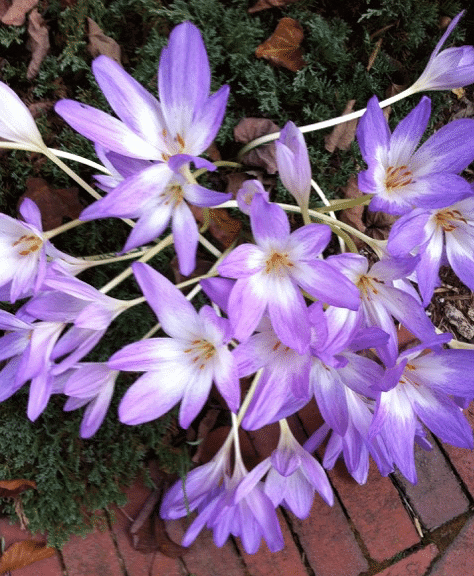
In the seasonal rush to plant spring-flowering bulbs, fall bloomers are often overlooked. To add to their undeserved obscurity, one of the loveliest — colchicum — suffers from an identity crisis. Often referred to as autumn crocus (which belongs to another genus altogether), Colchicum is a botanical name that’s easily mangled, causing confusion. And, of its many common names – meadow saffron, son-before-flower — walking into a nursery and asking for it by its other common name, “naked ladies,” takes a certain amount of courage and a steady gaze. If all this isn’t enough to keep you from seeking them out, the whole family has been reclassified. They’ve been ostracized by the Liliaceae family (lilies et al.) and now band together as Colchicaceae. There’s more: they’re not really bulbs, but corms (technically a swollen underground stem), and they produce big, strappy leaves in spring that are hard to camouflage.
Now that you know the worst, let’s get on with why these autumn gems deserve a place in our gardens. Quite simply, it’s because they’re so beautiful. The goblet-shaped flowers bloom in shades of lilac, pink or white, and stand five to eight inches (13 to 18 cm) tall and two to three inches (5 to 8 cm) wide. Planted singly or in generous drifts, they make an impact in the garden at a time when many plants are past their prime. Tucked under green-leaved spring-flowering shrubs, such as forsythias and rhododendrons, they offer a splash of fall colour to the drab branches. Colchicums also make ideal container plants — pop them into a pot of fading summer annuals and they’ll bloom a few weeks later, providing a fresh fall look. When they’ve finished blooming, plant them in the garden, where they’ll flower for years.
Because colchicums bloom “naked” — without their leaves — it’s best to combine them with leafy groundcovers, such as earlier-flowering cranesbills (Geranium spp. and cvs.), so the fall flowers rise up through the foliage, making the perennials appear to rebloom. Other effective partners include dark-leaved plants that show off colchicums’ pastel flowers, such as ‘Obsidian’ heuchera and black mondo grass.
Planting the corms among groundcovers also helps disguise the tall, fairly wide, hosta-like leaves that appear in the springtime. As frustrating as it may be, resist the impulse to cut down the foliage; it collects the energy needed to produce those lovely fall flowers.
How to grow colchicums
When to plant: late summer to early fall for blooms the same year. Corms must be fresh and not dried out.
How deep: about four inches (10 cm); a little deeper in sandy soil and shallower in rich organic soil.
Soil: well drained
Exposure: part shade, but plants will tolerate full sun if well watered.
Moisture: they prefer dry summers, so don’t irrigate during this dormant period.
Division: divide only if overcrowded; separate corms in early summer after foliage has ripened and plants are dormant.
Hardiness: Zone 4; in areas with scant snow cover, protect with evergreen boughs over winter.
Cultivars:
Colchicum ‘Autumn Queen’ lilac petals with silvery, checkered pattern
C. ‘Lilac Wonder’ amethyst blooms
C. ‘The Giant’ white-throated violet flowers
C. ‘Waterlily’ double, lavender-pink flowers
C. autumnale ‘Album’ single white flowers
Crocus or colchicum?
Colchicums are erroneously referred to as autumn crocuses, but they differ in many ways. True crocuses have three stamens, while colchicums have six. Crocus leaves are narrow with a central white stripe, but colchicums have wide, solid green leaves. The shoots of crocus emerge from the top of the corms; those of colchicums sprout off-centre. Beware that all parts of colchicums are toxic if ingested and may cause skin irritation. (That makes them pest-resistant, too.) Like colchicums, autumn crocuses are readily available and can be planted in late summer or early fall for blooms the same season. Although their flowers are more diminutive than those of colchicums, they make an impact when planted in groups or drifts.

thank you Lorraine for this wonderful write up on colchicums.
N OLD NEIGHBOUR OF MINE GAVE ME SOME CORM YEARS AGO AND THEY HAVE MULTIPLIED, I LOVE THEM WHEN THEY BLOOM. HE HAS LONG GONE TO HEQVEN AND I REMEMBER HIM. BUT MOST OF ALL, I KEPT WONDERING WHAT THOSE THICK LONG HOSTA LIKE LEAVES WERE IN THE SPRING AND SUMMER NOT REALISING THEY WERE THE COLCHICUMS, THANK GOODNESS I DID NOT CUT THEM OFF, I WONDERED WHAT THEY WERE A THE BIG LEAF NEVER BLOOMED IN THE SUMMER, BUT FADED INTO THE GROUND AND THEN IN THE FALL UP CAME THESE CROCUS LIKE BLOOMS. THANKS FOR THE EDUCATION.
can you tell me why my Carl Mackie shrub falls down and still lives and blooms beautifully and then after a few years gets huge but not upright, I have three in different areas of the garden, I lost one yers ago from this same behaviour.
I have Colchicums in my garden. I look forward to the flowers in the fall as they are so pretty. I always let the spring leaves slowly decompose into the flower bed. Has anyone heard of the folklore that the first snowfall happens a certain number of days after the Colchicum starts blooming? I have been trying to find out the number of days but no searches have come up with an answer. The closest I have come is Jack Frost is on the way once the Colchicums bloom.